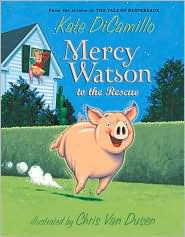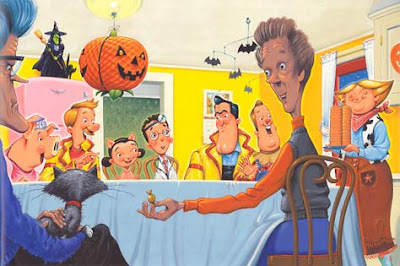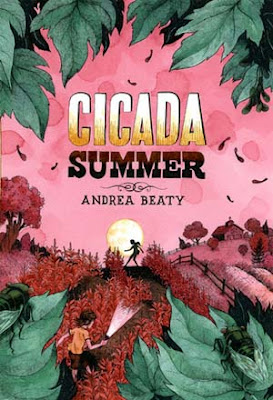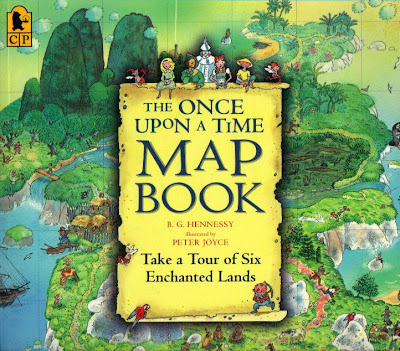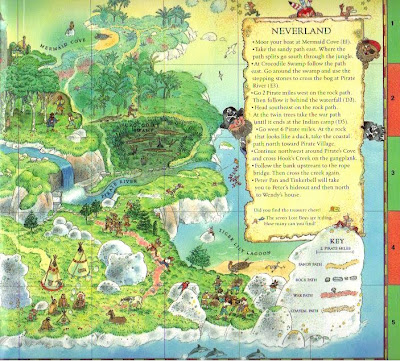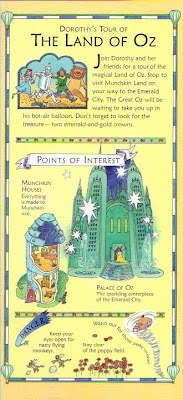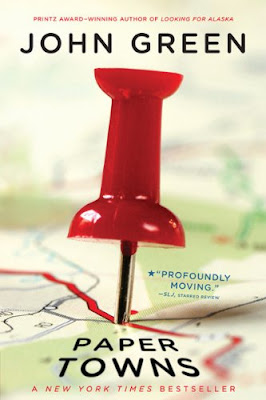
Paper Towns is John Green's third book and the first I have read. I am an instant admirer. As of this writing, Green has only three titles to his name - Looking for Alaska, his debut novel and winner of the Michael L Printz Award - the teen literature version of the Newbery Award, An Abundance of Katherines and Paper Towns. His most recent book, Will Grayson, Will Grayson was cowritten with the amazing editor and author David Leavithan, who is also the coauthor with Rachel Cohn of one of my all-time favorite teen books, Nick and Norah's Infinite Playlist. And, Green is part of the super-teen-triad, along with Maureen Johnson and Lauren Myracle, that created Let it Snow, a collection of three intertwined stories. Despite the fact that he has only a handful of published works under his belt, Green has made a huge impression on the world of teen literature that will last for years to come. His reputation is big enough that I found myself a bit skeptical when I opened Paper Towns but deeply satisfied and rewarded by the time I closed it. Green delivers exactly what I think makes a novel a work of true literature. His characters and plot are interesting and well-rounded and their crises compelling, but he takes his story to a higher level by weaving symbolic themes and literary references throughout his multilayered story.

I included both the paperback and hardcover images for Paper Towns because they are both brilliantly conceived and wonderfully representative of the story within. Where to begin? Margo Roth Spiegelman. Whitman's Leaves of Grass. Paper Towns. The Prom. If I had to sum up the thrust of this book in a gerneal, one sentence thesis for an English class essay, I think I would say that Paper Towns is about how you can think you know a person and even love a person, but ultimately you only know what s/he wants you to know. Of course identity, sense of self and personhood are key issues to a contemporary, first world teenage experience, but, rather than explore these issues from the inside out as most authors do, Green explores them from the outside in with the main character and narrator, Quentin Jacobsen, also known as Q, and his realization that he doesn't know all their is to know about a person he thinks he loves.
Being the (almost) lifelong neighbor to Margo Roth Spiegelman, the "most fantastically gorgeous creature that God ever created," is, in Q's mind, his one alloted lifetime miracle. Even without Quentin's glowing descriptions, Margo is clearly a unique and special person, as we see when she climbs through Q's window at midnight (after falling out of friendship with him several years back) and asks him to be her driver as she tackles her "eleven problems." With reservations, Q rolls his mom's minivan out of the garage and embarks on a night of helping Margo exact revenge on people he thought were her close friends and even boyfriend. Their first stop is the Publix store where Margo hands Q a hundred dollar bill and a list that includes, "3 whole Catfish, Wrapped separately/ Veet (It's for Shaving your legs Only you don't Need A razor It's with all the Girly cosmetic stuff)/ Vaseline/ six-pack, Mountain dew/ One dozen Tulips/ one Bottle Of water/ Tissues/ one Can of blue Spray paint." When Q comments on the "interesting capitalization" used in her list, Margo replies, "Yeah, I'm a big believer in random capitalization. The rules of capitalization are so unfair to the words in the middle." What follows is a truly inspired, calculated adventure that apparently exemplifies the outward persona that Margo projects to her peers.
Margo disappears after that night and Q finds himself following a sparse trail of clues that will lead him to another Margo, one that she has never shared with even her closest friends. This isn't the first time Margo has taken off or left clues as to her whereabouts, which have included letters in the bottom of a bowl of alphabet soup. When he notices a poster of a guy playing a guitar that has the words THIS MACHINE KILLS FASCISTS taped to the backside of the window shade in Margo's room (which is directly across from Q's) Q realizes that this is a clue for him and he enlists the help of his two closest friends, Ben, a Prom obsessed big talking fan of the "honeybunnies" and Radar, a compulsive editor of entries at Omnictionary, Green's inspired fictional version of Wikipedia. Radar is constantly checking entries for accuracy and righting the juvenile wrongs committed by others as well as adding his own entries. Because of this, he is very savvy when it comes to the internet and quickly links the web of clues and leads left behind for Q to follow.

I think that it is hard to write a relevant book for teens these days without making specific cultural references because consumerism and media are such tremendous parts of everyday life in the 21st century, yet they are also rapidly replaced by new trends. Thus, to mark a novel with these references is to date the text and possible detract from the more profound aspects of the story. I think that Green finds a brilliant way around this paradox by having Margo be the kind of person who is interested in anything but contemporary teen culture. Maybe I just think that this is brilliant because that's the kind of teenager I tried to be in the 80s - music was only interesting if it was made before I was born, and the same went for the literature that I read, which ranged from Fitzgerald and Maughm up to Salinger, Kerouac and Herman Hesse. Anyway, Margo's interests, as the boys learn when they inspect her bedroom while her parents are out, are encompassed in an extensive record collection that includes John Coltrane, Dizzy Gillespie, Guided by Voices, the Buzzcocks, the Blind Boys of Alabama and Billy Bragg, who's Woody Guthrie tribute album has the same picture on it as the poster and another clue - the song "Walt Whitman's Niece" had been circled. As Q pores over the heavily underlined copy of Leaves of Grass he finds in Margo's bookshelf, he tries to understand what she wants him to know, reading the text in as many different ways as he can. Green quotes extensively from the text in his book and I love, absolutely love, the idea that hundreds and thousands of teenagers who would otherwise never read a line of Whitman's poetry are being exposed to "Song of Myself."
I am so tempted to go on describing Margo's clues and Green's exemplary plotting of this novel, but I definitely don't want to deprive anyone of the joy of discovery with this amazing book. What I do want to mention is Green's wonderful metaphorical and physical use of the concept of "paper towns." In the first section of the book, Margo and Q stand on the roof of one of the tallest buildings in Orlando in the middle of the night. Q thinks the city below them is beautiful, but Margo tells him "Everything's uglier close up." She goes on to tell Q that he lives in a paper town, "all those cul-de-sacs, those streets that turn in on themselves, all those houses that were built to fall apart. All those people living in their paper houses that were built to fall apart. All those paper people living in their paper houses, burning the future to stay warm . . . Everyone demented with the mania of owning things. All the things paper-thin and paper-frail. And all the people, too. I've lived here for eighteen years and I have never once in my life come across anyone who cares about anything that matters." The use of this great metaphor exemplifies Margo's feelings of emptiness and outsider status, feelings Q remains oblivious to even as he listens to her. Much later in the book and in his search Q is discussing a once troubled classmate who is going on to college with his parents, both of whom are child psychologists. Q's dad says, "The longer I do my job the more I realize that humans lack good mirrors. It's so hard for anyone to show us how we look, so hard for us to show anyone how we feel." His mother adds, "But isn't it also that on some fundamental level we find it difficult to understand that other people are human beings the same way we are? We idealize them as gods or dismiss them as animals." He father finishes the thought with, "Consciousness makes for poor windows, too." Q listens and thinks to himself, "Margo Roth Spiegelman was a person, too. And I have never quite thought of her that way, not really; it was a failure of all my previous imaginings. All along - not only since she left, but for a decade before - I had been imagining her without listening, without knowing that she made as poor a window as I did. And so I could not imagine her as a person who could feel fear, who could feel isolated in a room full of people, who could be shy about her record collection because it was too personal to share. Someone who might read travel books to escape having to live in the town so many people escape to. Someone who - because no one thought she was a person - had no one to really talk to." Personhood and recognizing the existence of a self in others seems to be a strong theme in the teen literature I have been reading of late. In these books, psychological analysis by secondary characters and introspection on the part of the main characters are integral parts of the plot, whether the story is based in reality or fantasy. I am very excited to see this line of questioning, especially in teen literature where the answers to this questioning can be concrete and clear cut, whereas an adult work of literature might require more ambiguity and work on the part of the reader to make sense of the personal and moral dilemmas faced by the characters in the novel. I am so happy to see that these authors, in their own creative ways, are asking readers to think about others and to think about the importance of connections (or lack of connections) we make with others in our lives. After years of adulthood and parenthood (and therapy) this, to me, seems like one of the greatest accomplishments we can make in our lives - being aware of and empathetic to the existence of those around us and connecting in a meaningful way that eases the pain and deepens the enjoyment of life.
Also, unbeknownst to me, "paper towns "has a literal meaning as well. Apparently, a paper town was a creation of mapmakers to protect against copyright infringement. A fictitious town was added to a map by the cartographers and, if the map was copied without permission, the mapmakers would know when the fake town showed up on another company's version of the map. Apparently, Mountweazel (Margo's dog is named Myrna Mountweazel) is also a fictitious name created to be used as a fake entry in an encyclopedia. Thanks Omnictionary, uh, I mean Wikipedia! Green masterfully weaves the metaphorical and concrete ideas of paper towns throughout the novel as clues to Margo's whereabouts and clues to her internal struggle. Finally, I was so engrossed with the layering of plot lines, metaphors, clues and cultural references that I forgot to mention that Paper Towns is laugh out loud funny on almost every page. John Green really does deserve all the praise and attention he has garnered and I look forward to more from him in the future.
For those of you interested in more of the world of Green, he has a YouTube channel that he started with his brother, Hank, vlogbrothers, which began as a way for the brothers to communicate in 2007. This spawned, as Green's bio notes, "a community of people called nerdfighters who fight for intellectualism and to decrease the overall worldwide level of suck. (Decreasing suck takes many forms: Nerdfighters have raised hundreds of thousands of dollars to fight poverty in the developing world; they also planted thousands of trees around the world in May of 2010 to celebrate Hank’s 30th birthday.) " The Nerdfighters are a force to be reckoned with. Also, something I absolutely love about the relatively "small" community of teen writers is that they are very much a community. Even before I decided to review teen literature on my blog I was an avid reader of this genre, hoping to keep pace with my daughter.
As a reader and bookseller, I noticed that a lot of the same authors contributed to group works and, when I began reading the Author's Notes and various blogs by the authors, I realized that they really are a community. They read each other's works, support each other with link on their blogs and shout outs for new books and tour together. John Green happens to be in a writing group that includes Emily Jenkins (aka E Lockhart) Scott Westerfeld, Justine Larbalestier and Maureen Johnson. I think that is is amazingly wonderful and, if I may make a leap, perhaps it is this community and connection among the authors themselves that comes through in the literature that they write. Whatever it is, this is a really cool group of people doing some pretty cool stuff in the world and I wouldn't think twice about encouraging my daughter to read their books and more! Maybe even join up with the Nerdfighters!






